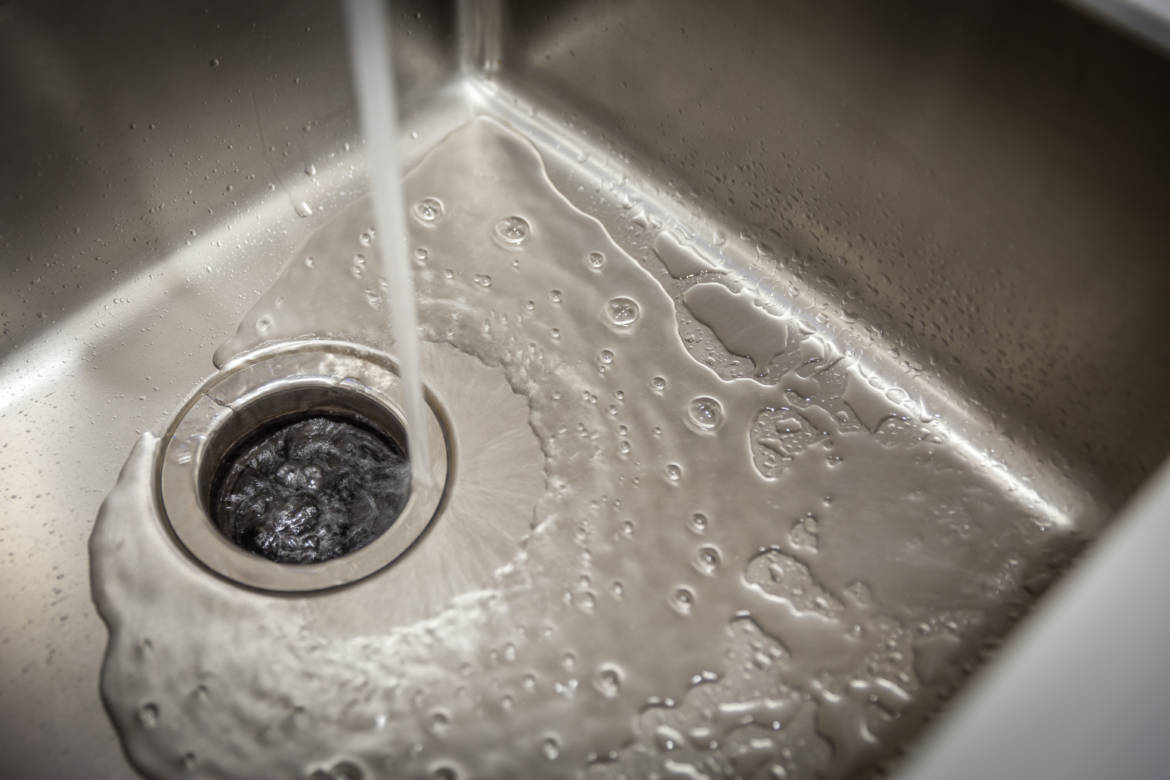The Ultimate Garbage Disposal Troubleshooting Guide

The garbage disposal can be one of the handiest appliances in your kitchen. So much so, that you come to rely on it to the point that a broken garbage disposal can totally upset your daily routine. But, your garbage disposal is also one of your most used and abused appliances. Since it sits between your sink and drain pipes, everything that goes down the sink goes through the garbage disposal. This includes not only the food items you intend for the garbage disposal to grind up, but also all the grease, oil and other particles you rinse and scrape from your dishes. Sometimes even items that shouldn’t go down the garbage disposal, like silverware or bones, make their way into it. These things can lead to all sorts of garbage disposal problems.
How to fix a Garbage Disposal that only Hums
If you turn your garbage disposal on and it only hums, chances are something is jammed in the blades or between the blades and the casing. This could be anything from the aforementioned silverware or bones, to banana peels, meat, or just built up food particles. The humming sound comes from your motor trying to turn the blades while something is stuck in the garbage disposal. If this happens to you, turn off your garbage disposal immediately or your motor could burn out.
Next, before you go trying to dig anything out, unplug the garbage disposal and turn off the circuit breaker that controls it. This will help prevent any serious injury to you, including electric shock.
Now look into the drain hole to see if there is anything stuck between the blades and the side of the disposal. You may want to use a flashlight to help you see better. The easiest way to remove any obstruction you should find may be with tongs. Even though you’ve cut all power to the garbage disposal, it is still good practice to keep your hands out of it. Once you have cleared the blockage, restore the power to the garbage disposal and try it out to see if this has solved your problem.
If it’s still humming, turn it off again; unplug it; and turn off the circuit breaker. There should have been an Allen (hex) wrench included with your garbage disposal. If not, get a one-quarter inch Allen wrench and insert it into the socket at the bottom of your disposal unit. Turn it back and forth to manually move the grinding plate upon which the blades sit.
If your unit doesn’t have a hex socket, you can manually turn the grinding plate by using a broom handle or something similar. Just be careful that you aren’t too rough. After you have done this, look into your garbage disposal for any objects that may have become dislodged and remove them with your tongs. Once more, test your disposal.
If the humming continues, turn off the disposal. Then locate the red reset button at the bottom of your appliance. The disposal could have shut itself off to keep it from overheating. Press the reset button and test your garbage disposal again.
If all you get is more humming, it is likely that your garbage disposal has worn out and needs to be replaced.
Why is my Garbage Disposal Leaking?
To answer this question, you must know how to find the leak. First, unplug your garbage disposal and turn off the circuit breaker. Next, make sure the outside of your disposal is dry. Then put a stopper in your sink and fill it part way with water. Add a color of food coloring to the water that will show up on your unit. This will help you pinpoint the leak.
The three most common places to find leaks from your garbage disposal are from the top at the sink’s flange, from the side where the dishwasher and main drain lines connect, or from the bottom. With the stopper still in, look under the sink for any leaks coming from the top where the garbage disposal connects to the sink drain. If you don’t see any, pull out the stopper and watch for leaks at the drain lines, or water leaking from the bottom of the garbage disposal. If you see water dripping from the bottom, make sure it’s not actually coming down from somewhere else.
If you find a leak at the top of the garbage disposal, it is most likely being caused by the metal sink flange or the plumber’s putty that typically seals the flange. In this situation, there are two reasons you might not be getting a watertight seal at the flange. First, the flange is held in place by bolts. If these become loose, you could lose the seal. Furthermore, if the plumber’s putty should deteriorate, the seal will also break down.
There is another possible reason why you might be experiencing leaking from the top of the garbage disposal. That is if the rubber gasket associated with the flange begins to leak. This can happen when the gasket gets old and cracks or dries up, or if the garbage disposal is taken out and put back in and the gasket is not sealed correctly, or if it is not attached uniformly.
If you find a leak from the side of your garbage disposal, it will most likely be from either the dishwasher drain line or the main drain line to the sewer. In this situation, a leak from the dishwasher line could be from the clamp that connects it to the garbage disposal, or the hose could be cracked. (You may only be able to detect such a leak when the dishwasher is operating.) If you realize it’s actually your dishwasher that is broken, you may want to look into this dishwasher troubleshooting guide. Otherwise, a leak from the main drain line could be coming from loose screws at its connection with the garbage disposal, or its internal gasket could be worn out.
Finally, if you find water leaking from the bottom of your garbage disposal, sometimes from the reset button, chances are that you have one or more broken seals inside your unit. This is generally a function of age and wear and tear.
How to fix a Leaking Garbage Disposal
To replace a leaking rubber gasket, you will have to remove the garbage disposal from its mounting.
- First, unplug it and turn off the circuit breaker.
- Disconnect the dishwasher and main drain lines.
- Remove the garbage disposal by disconnecting its mounting. The disposal should then come right down.
- Replace the worn gasket, making sure the new one fits into its place and lays flat. As you return the garbage disposal to its position, ensure that the gasket remains flat prior to fixing it in place.
- Make sure the three mounting grooves are properly set.
- Once the garbage disposal is locked in, reconnect the drain lines and test again for leaks.
If the plumber’s putty is the problem, you may be able to fix the leak without having to remove the garbage disposal by just replacing the putty. Do this by loosening the retaining bolts a bit. Once you have created a gap, you can push the new plumber’s putty in between the flange and the pipe. Tighten the bolts again to hold the putty securely.
Otherwise, you’ll have to detach the garbage disposal and reseal the leaking flange. This is probably the preferable method as it ensures the best seal.
- First, unplug the garbage disposal and turn off the circuit breaker.
- Then detach the unit from its mounting and let it come down.
- Detach the dishwasher and main drain lines from your garbage disposal
- Loosen the bolts or screws that keep the flange tight. There is actually an upper flange and a lower flange.
- Pop out the clip that holds the lower flange in place.
- Lift the upper flange out of the sink.
- Next, clean away all of the old plumber’s putty.
- Then take some putty and make a rope of even width and wind it around the rim of the upper flange.
- Press the upper flange back into the top of the sink and reattach the lower flange.
- Evenly tighten the bolts or screws at the flange.
- Remove any excess putty.
- Reattach the disposal, reconnect the drain lines and test for leaks
Now if the leaking is coming from your dishwasher drain line, you have two possible problems. The metal clamp which attaches this drain line to your garbage disposal may be loose, or you may have a crack in your dishwasher drain line. For a loose clamp, just try tightening the screws. A cracked drain line should, of course, be replaced.
If your main drain line is leaking – it is the larger of the two drain lines coming off of the disposal – you may need to tighten the screws which attach it to your unit. Also, there is a rubber gasket inside this drain line that may be worn out and need to be replaced.
Water leaking from the bottom of the garbage disposal is a different matter altogether. As previously stated, this usually indicates that you have cracks inside the lining of your unit. This is a function of age and wear and tear for the most part. A garbage disposal should last between 8 to 15 years, but it can be less. If the internal seals have become compromised such that you are seeing this water leaking from the bottom of your garbage disposal, it’s probably time to replace it.
How to Make a Garbage Disposal Smell Better
As discussed earlier, your garbage disposal is the pass-through point for everything that goes down your sink, including grease, oil, butter, and all manner of food particles. These fats can accumulate over time in your garbage disposal and begin to trap bits of food, which, in turn, will begin to emit noxious odors as they decompose.
Here are 3 easy ways to clean your garbage disposal plus a great way to freshen it up even more afterward.
- Ice Cubes: Take about 2 handfuls of ice cubes and about a handful of kosher (coarse) salt and toss it in the garbage disposal. Turn on the cold water and your garbage disposal and let it run until all of the ice cubes are gone. (You may be surprised at the amount of grime you see coming out of your disposal during this process.) The ice cubes will clean food and whatever muck there is off of the blades, while the salt will clean the inside of the unit.
- Water and Dish Soap: Stop up the sink. Add a few good squirts of grease cutting dish soap. Fill the sink about half of the way full with very hot water, mixing the soap and water well. Pull out the stopper and turn on the garbage disposal. Be sure you don’t let your garbage disposal keep running after all the soapy water is through. For very dirty disposals, you can repeat this procedure.
- Vinegar and Baking Soda: Vinegar is often used as a deodorizer and can even kill some bacteria. Pour one-half to one cup of baking soda and an equal amount of white vinegar into your garbage disposal. Let it sit (it will foam) for about 10 minutes. Then run very hot to boiling water down the sink to clear the mixture as well as any gunk it has removed. While this is a great method to clean and deodorize your garbage disposal, keep in mind that vinegar is very acidic and can damage the rubber parts of your unit if used too often.
Once you have cleaned your unit, if you would like an even fresher smell, you can always use lemon in the garbage disposal. Actually, orange and lime work well too. Here’s what you do. Cut one of these citrus fruits into small slices, turn on the cold water and the garbage disposal and drop the slices slowly into the unit so nothing gets wedged between the blades and the housing. When you’re done, your disposal should have a fresh citrus smell.
My Garbage Disposal Smells like Sewage
Now if what you’re smelling coming out of your garbage disposal isn’t rotting food, but an actual sewage smell, you’ve got a different problem. What you are smelling is most likely sewer gas. But how does this get into your home? There is usually one of two ways that this can happen. Either the sink’s trap isn’t doing its job, or there’s a problem with the plumbing vent.
Your sink has an elbow, or U-shaped curve in the pipe underneath it, called the “trap.” This trap holds some water in it all of the time. The water keeps sewer gas from flowing back up your main sewer line and into your home. If the water in the trap should evaporate for any reason, such as if you were away and not using the sink for a while, or if there is a leak in the trap causing the water level to be insufficient, then sewer gas can travel up the line and into your kitchen.
To address this problem, run water into the pipes to refill an evaporated trap. If the trap is leaking, replace it. If, however, you do not find a trap under your sink, this may no longer be a DIY project.
If the trap is not the problem, it may be the plumbing vent instead. These vents are basically long thin pipes that run up and out through your roof. They vent your main sewer line to the outside. Because these vents open to the outside, they can get clogged with all sorts of things, even bird’s nests. When this happens, sewer gas can travel up through your main drain and garbage disposal and into your house. Sometimes these vents will develop leaks as well, with the same consequences – sewer gas in your home. If the plumbing vent turns out to be the problem, this may not be a DIY project either.




